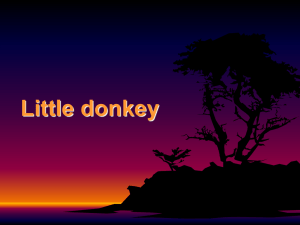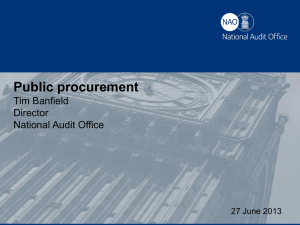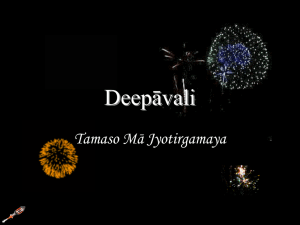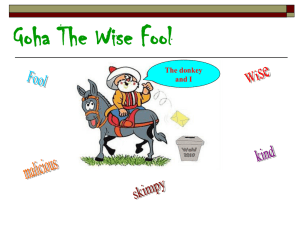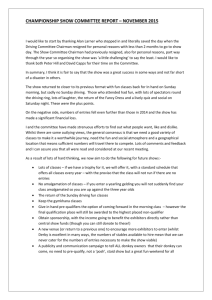Life and Death are Wearing Me Out
advertisement
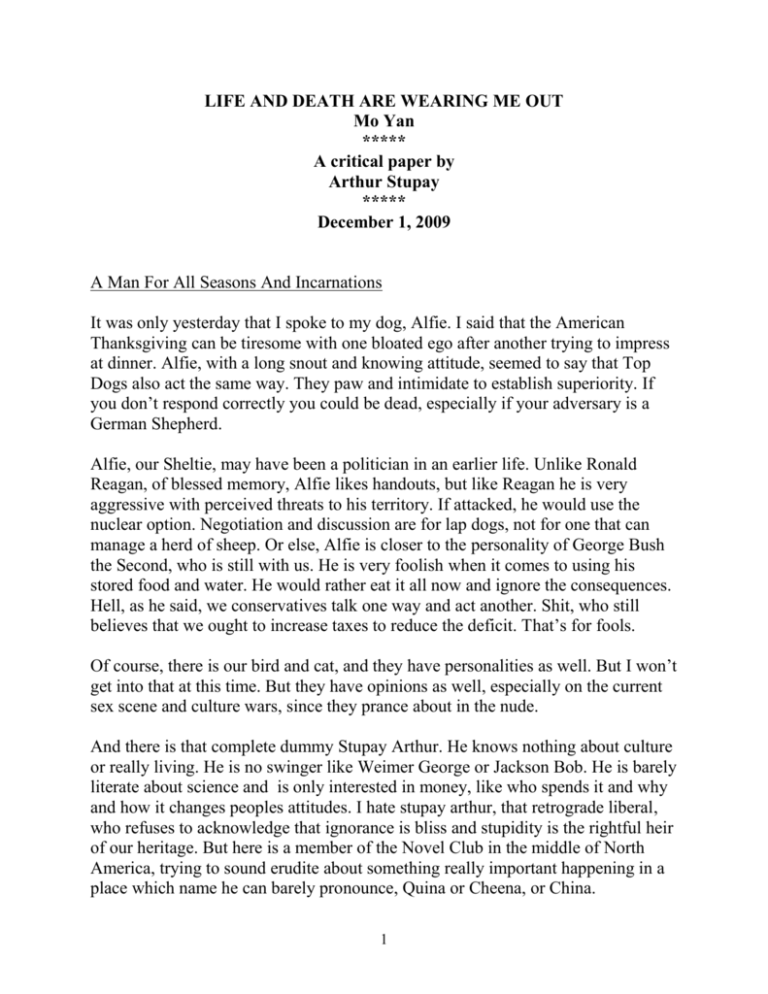
LIFE AND DEATH ARE WEARING ME OUT Mo Yan ***** A critical paper by Arthur Stupay ***** December 1, 2009 A Man For All Seasons And Incarnations It was only yesterday that I spoke to my dog, Alfie. I said that the American Thanksgiving can be tiresome with one bloated ego after another trying to impress at dinner. Alfie, with a long snout and knowing attitude, seemed to say that Top Dogs also act the same way. They paw and intimidate to establish superiority. If you don’t respond correctly you could be dead, especially if your adversary is a German Shepherd. Alfie, our Sheltie, may have been a politician in an earlier life. Unlike Ronald Reagan, of blessed memory, Alfie likes handouts, but like Reagan he is very aggressive with perceived threats to his territory. If attacked, he would use the nuclear option. Negotiation and discussion are for lap dogs, not for one that can manage a herd of sheep. Or else, Alfie is closer to the personality of George Bush the Second, who is still with us. He is very foolish when it comes to using his stored food and water. He would rather eat it all now and ignore the consequences. Hell, as he said, we conservatives talk one way and act another. Shit, who still believes that we ought to increase taxes to reduce the deficit. That’s for fools. Of course, there is our bird and cat, and they have personalities as well. But I won’t get into that at this time. But they have opinions as well, especially on the current sex scene and culture wars, since they prance about in the nude. And there is that complete dummy Stupay Arthur. He knows nothing about culture or really living. He is no swinger like Weimer George or Jackson Bob. He is barely literate about science and is only interested in money, like who spends it and why and how it changes peoples attitudes. I hate stupay arthur, that retrograde liberal, who refuses to acknowledge that ignorance is bliss and stupidity is the rightful heir of our heritage. But here is a member of the Novel Club in the middle of North America, trying to sound erudite about something really important happening in a place which name he can barely pronounce, Quina or Cheena, or China. 1 Like Stupay Arthur, Mo Yan gave us a quick introduction to the modern history of China. It was all sturm und drang, since the last emperor, Pu Yi, aged seven, and barely toilet trained, was deposed. In China, it was war for leadership, war against the European Imperialists, war against the Communists, war against the Japanese invader. War and its attendant chaos was the background of the first half of the twentieth century in China. Then came the victory of the Great Leader, Chairman Mao, who started as a university student and librarian, who later closed universities and assigned well known professors to hard labor in the rice paddies to better understand the peasants, who he thought were the vital force for the regeneration of Chinese power. China lost twenty five years of potential progress and maybe more than 50 million citizens in the nonsense that was Mao’s program, from the reeducation which brought on the Cultural Revolution to other forms of reprogramming. Exactly what we are seeing in Korea and Iran, among many other places. At least, China has Mo Yan who can write about the contradictions and live to tell it. The book starts on January 1 1950, just after the Chinese Nationalists, under Chiang Kai-shek and Madame Chiang removed themselves (or more accurately were forced out by the Communists under Mao Tse-tung) to Taiwan with many of the artistic treasures of the Mainland, as well as their wealth, their influence on the Americans, and their fanatical belief in their ultimate victory. Ximen Nao, a rich landowner in China at the wrong time and the wrong place, has been tortured for two years trying to establish his innocence of exploitation of his workers and family. He appears before the great lord of the underworld, the devil himself, Lord Yama. To force him to admit his sins, he is dropped into a vat of boiling oil for an hour or so, “in which he tumbled and turned and sizzled like a fried chicken.” He was then speared and carried to the palace steps. Lord Yama intones, Ximen Nao, whose name means West Gate Riot, is more rioting in your plans? He appeared before Lord Yama, after he was shot dead and tossed into the water at the age of thirty, despite all his efforts to improve the life of his town, Northeast Gaomi Township. He restored temples, shared the grain with his peasants and was charitable to his community. He said, “You’ll not get me to confess. I am innocent, and I ask to be sent back so I can ask those people to their face what I was guilty of.” Lord Yama has had enough of Ximen Nao and instructs his helpers, Ox Head and Horse Face, to send Ximen Nao back. They instruct him to use 2 donkey blood to restore his skin after being fried to a crisp, which they provide, although it is a nauseating mess. He is then led through a dark tunnel, with gigantic bats, with foul tasting guano falling on his head. At that point, a white haired old women reached out to fill a bowl of foul stuff and our hero was told to drink it, which he pushed away, saying, “I want to hold on to my suffering, worries and hostilities. Otherwise returning to the world is meaningless. The attendants were mortified and took him back upstairs to Gaomi township, which after two years he hardly remembered. The land reform program was implemented, where land is given or leased to landless peasants. He recognizes some people, including his son and daughter, the children of one of his two concubines, but no one seems to respond to him. On the ground in Gaomi, he is propelled forward, but it not as he expected. He is pushed through the birth canal of a female donkey. He is reborn not as a landowner, but as a white hoofed donkey with floppy tender lips. The man behind the donkey with a broad grin is his former hired hand, Lan Lian, whom he rescued when he was orphaned and left in front of the God of War Temple. Ximen Nao was a rich man who had eighty acres of farmland and gold and silver. He then takes as his wife the second daughter of the richest man in Baima, who after marriage became know as Ximen Bai, who had a well-proportioned lower body. The only flaw in this perfect marriage was that she had not yet produced a child. This was remedied by taking two concubines, Yingchun, one who produced a son, Ximen Jinlong, the successful revolutionary Communist who becomes head of this revolutionary committee or the other. She also gives birth to Ximen Baofeng, the “barefoot doctor.” The other concubine was Wu Quixiang, who after Ximen Nao’s death marries Huang Tong, later an official of the regional authority. In this chapter of one hundred pages that is as closely written as James Joyce Ulysses, he describes his life and death as well as the changes that occurred in the country. His own estate is now abolished. Ximen donkey now brays, “My friend I shall now relate the events of 1958. Mo Yan did that in many of his stories, but he was spinning nonsense.” He continues, “I will omit any discussion of the great smelting campaign and the backyard furnaces. Nor will I touch upon the communal kitchens ... Nor the abolition of villages and amalgamating production brigades, creating a country-wide People’s Commune overnight.” He focuses on his former worker, Lan Lian, his master now, who stubbornly remains an independent farmer and the only one in his district and in the country. Ximen donkey observes, “In the torrent of collectivization, the residents of the Peoples Commune ignored Lan 3 Lian…Then when the co-ops harvest was left to rot while people smelt steel, he comfortably brought in a bumper crop of grain from his eight acres. This was a true story. Mao’s emphasis on steel at the expense of crops led to the starvation of tens of millions. Only a storyteller could get away with telling it.. Later the donkey is confiscated for the county chief as a special honor to carry him to his home region. Ximen’s hoof gets stuck in a mountain crevice. Later the injured hoof broke off and the donkey’s life is endangered, because injured donkeys could fall prey to hungry villagers. The starving people turned into wild animals. They ate bark and grass and then went after the animals, killing Ximen donkey for food, although his protector Lin Lian tried to protect him. He was cut into pieces, roasted and eaten. We are told that party leaders fancied donkey meat. Then Lan Lian had to find a replacement for his donkey. But the donkey market was empty, but the oxen market was full. A trader offers Lan Lian a half breed sired by a Swiss Simmental and Mongol ox. The little ox is now the second reincarnation of our hero. This section is slightly longer than the donkey section. Its in this section that Lan Lian announces his independence to his step children. He says that “joining a commune is voluntary. Leaving it is a matter of individual choice. Do our officials have more to say than Mao Zedong? I refuse to give in to them.” The time period is now into April and May 1965, five years after the previous period. It was an intense period to force peasants to conform to the party dictates— to hew the path of Socialism. Here there is intense pressure put on Lan Lian by his cousin, Xemin Jinlong, the son of Xemin Nao by his first concunbine, Yingchun, whereas Lan Lian is from his second concubine Wu Quixiang. Here we see the growing up and hardening of attitudes of the younger cadres. As Lan Jiefong says, “Dad, we can’t follow you down this dead end into this darkness. People say that you are like a rock in the crapper, hard and stinky.” This is the most political of the sections. Here the ox refuses to be led away into the Cooperative. And Ximen Jinlong strikes the ox, attaches a painful nose ring and prods him with a hot poker. Nothing will move this ox. After repeated brutal whipping and pulling, a fire is built under the stubborn ox and even then with half his butt gone, he refuses to move. He, the ox, the ghost of Ximen Nao, eventually dies. It is now the 1970s. Ximen Nao is dead but he is not out. Again, Lord Yama is asked by Ximen Nao to return again to the living world so that he can make his case to the people. Lord Yama says “Nao, I’ve had all I can take from you. If every ghost was as much trouble here, chaos would reign.” Yama mentions that he may 4 return as an only son to an owner of a cosmetics company who drives a BMW. But Lord Yama fools him again. Ximen Nao returns as the last of 16 piglets. This is longest section and lasts almost 175 pages. Here we find the romantic relationships between Jiefong, Jin Long and the two daughters of Wu Quiziang and Huang Tong, a county official. At the same time, there are a lot of barbs about speeches given by county officials and the operation of pig farms and the machinations of officials for power. At one point Jin Long says, “Every pig born is a cannon shell fired into the stronghold of the imperialists, revisionists and reactionaries. We must ride the mighty east wind of the Cultural Revolution to carry out the pig program outlined by our supreme leader, Chairman Mao.” This chapter ends with a fight that started between the foxes and pigs over food on the shoals of the river. “A fierce territorial battle erupted between the pigs and foxes and ended when the cadre drove the foxes off of the shoal. Then the cadres turned toward the pigs, under the leadership of the King Pig, Diao Xiaosan, a boar. A Pig Slaughter is about to commence. This eventually led to the death of King Pig, the boar and eventually to the drowning of Pig sixteen, our hero, who saved several children who had fallen through the ice into the river. We are now in 1990s. Again, two of Lord Yama’s attendants appeared and brought him before Lord Yama, saying, “I’m going to settle scores with that old dog.” Then as you would expect he was reborn in a kennel as a dog. This is a long section, but the narrative is helped by several love scenes as Lan Jiefang leaves his wife, Huang Hezuo, whom he has not kissed in decades, and falls in love with a woman twenty years younger, Pang Chunmiao. She is also the sister of a party leader Pang Kangmei. At this point, the party cadres no longer walk to events they are driven in caravans of fancy limousines and even a Ford Crown . In the Dog Spirit, Dog Number Four, our hero, witnesses a plan by Ximen Jinlong to turn Ximen Village into a Resort Village to bring visitors and money into the town. He argues that Cultural Revolution artifacts could be marketed. Tourists would be permitted to participate in Recalling Bitterness meetings, watch Recalling Bitterness plays and eat Recalling Bitterness meals. It would be a monument to the one independent farmer Lan Lian, an adopted son of Ximen Nao. This turns the County Committee against Ximen Jinlong and he is demoted and discredited. Dog Four dies when he lies down in his appointed grave site near his mistress, Huang Hezuo. This is practically the end. Now a Shakespeare tragedy takes over and nearly every one we revere dies in less than five pages out of 540. Kaifeng and Chungmei die, but Huzhu and Jiefong are reunited, maybe the only happy part of the book. The dog or Ximen Nao is reborn again as a monkey and finally into a child with a Big Head who is a hemophiliac, so he can be saved by Huzhu’s hair. 5 What is to made of this enormous panorama of political times, people, animals, as well as tragedies, stupidities and glory. It wasn’t all a waste, since China has now been reborn as the fourth largest economy. Its culture is booming. Its people are entering the 21st century with new homes in elevator buildings, automobiles and a stock market and savings. I think that this is Mo Yan’s idea to present the landscape and portray the development, and the ultimate joy, love between people. I liked it as an exotic and rollicking tale of a foreign culture. Is it stranger than Orhan Pamuk’s Turkey or Boleslav Prus’ Poland? Let’s discuss that. Questions for Discussion 1. Can you think of why he chose the donkey, ox, pig, dog, monkey and hemophiliac child as vehicles to tell his story? 2. Is there a hero or heroine in the tale? Which character rings true? 3. Is this an effective technique to convey the transformations in the society? Who did it better? 4. Does it work on a literary level? Was it interesting? Did you have any connection to any of the characters? What did you think of the ending? 5. Compare and contrast this work to some others like Pamuk and Prus as critics of their societies and culture. 6. What do you take away from this novel? . 6
